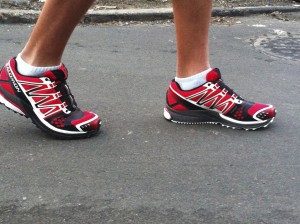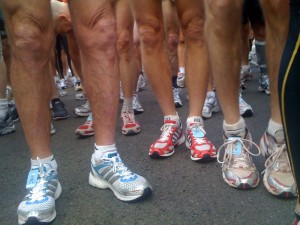New shoes can be the motivation every runner needs to get out & hit their bests… but they can also cause a few problems. Some people are lucky & can slip straight into a new pair of runners without any problems while others need to break in the new shoes. Even just transitioning to the new version of your current model of shoe can cause a  few blisters so if you feel the change ease in with the following strategies;
few blisters so if you feel the change ease in with the following strategies;
- Alternate your new shoes & old shoes each run for the first couple of weeks
- Use the inner sole of the old shoes in the new shoes
- Only run your shorter runs in your new shoes til you feel comfortable that they won’t cause any problems
- Use tape or Vaseline to reduce friction on common sore spots til the shoe become ‘personalised’ to your foot.
How long do you keep your shoes? How long should shoes last?
Why do new shoes hurt?
Foot shape will be one determinant of how you feel. Looking at your inner sole you’ll see the wear pattern from your foot. If the grooves are deep or the wear is quite obvious this is a likely spot of rubbing. Looking at your feet you’ll also often see callouses (a natural buffer) built up on areas of high contact.
The shoe type will also determine this, but hopefully you’ve chosen a good fitting shoe or been to a specialist running shop. Pretty colours don’t keep them comfortable! Make sure your sizing is correct. It’s an obvious point, but shoes that are too big will allow you to slide forward in the shoes, especially running down hill or when slowing down, so you’ll increase the rubbing. The same principle applies with correctly tying your laces. It should be tight enough to keep the shoe on but not too tight that it restricts your foot or increases the pressure or rubbing. Another factor which can effect wear & shoe life is your body weight. A size 10 runner weighing 96kg is going to go through the same model of shoes quicker then the runner weighing only 70kg.
determine this, but hopefully you’ve chosen a good fitting shoe or been to a specialist running shop. Pretty colours don’t keep them comfortable! Make sure your sizing is correct. It’s an obvious point, but shoes that are too big will allow you to slide forward in the shoes, especially running down hill or when slowing down, so you’ll increase the rubbing. The same principle applies with correctly tying your laces. It should be tight enough to keep the shoe on but not too tight that it restricts your foot or increases the pressure or rubbing. Another factor which can effect wear & shoe life is your body weight. A size 10 runner weighing 96kg is going to go through the same model of shoes quicker then the runner weighing only 70kg.
Use these factors to work out your running shoe fatigue profile.



Speak Your Mind